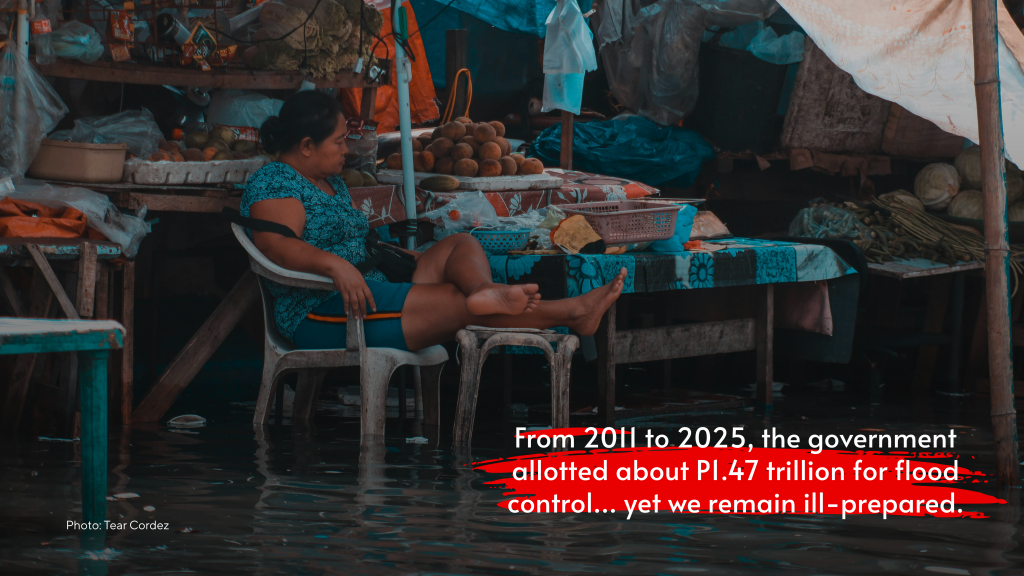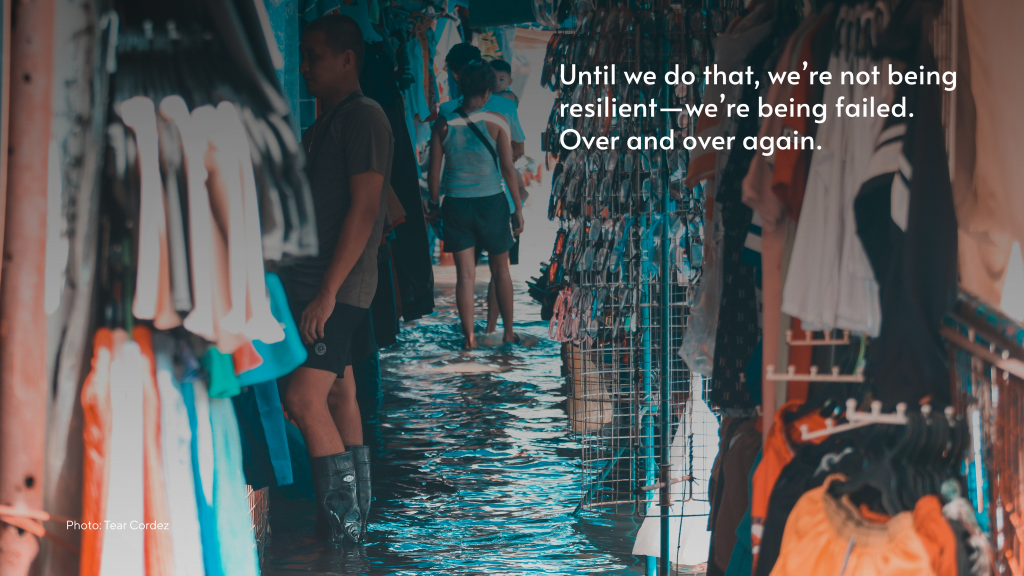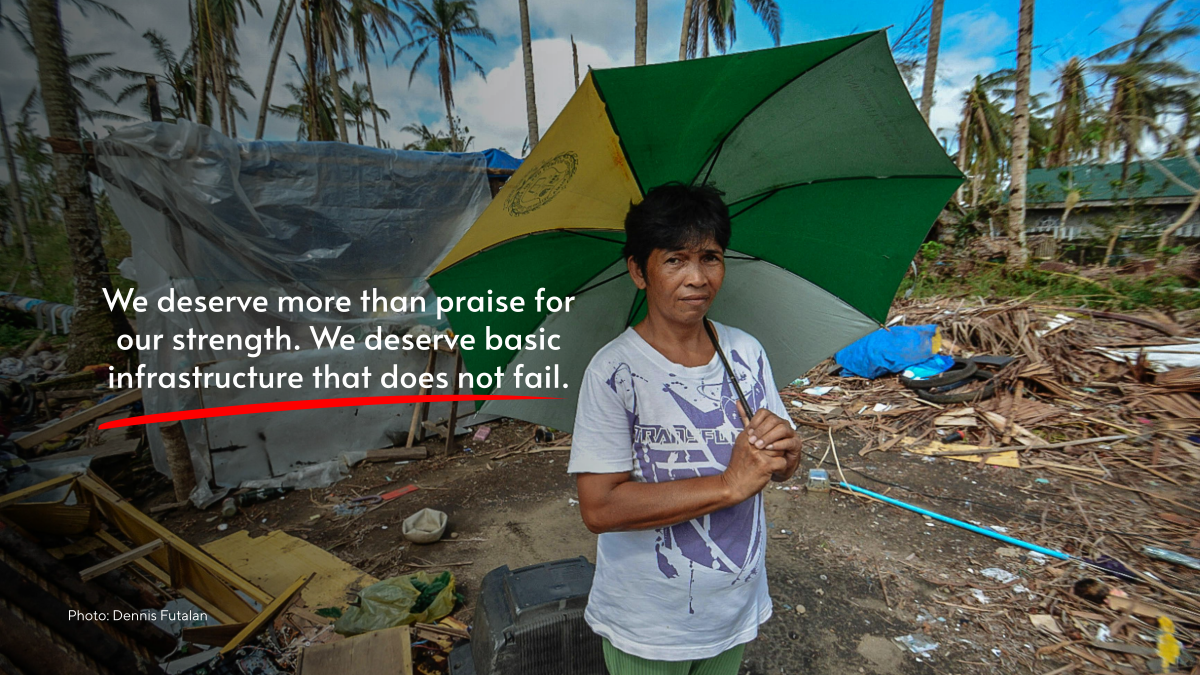The hardest questions often start with ‘when’. In the recent onslaught of Crising, Dante, and now Emong, there’s a question that’s still left unanswered despite years and years of going through the same season—when will we stop glorifying Filipino resilience and see actual changes we deserve?
Every year, an average of 20 tropical cyclones (TCs) enter the country’s Area of Responsibility, with typically 8 or 9 intensifying into typhoons. Five of which make landfall and can potentially become destructive. If you look at it plainly, in 365 days, many Filipinos are five times at risk of getting displaced—losing their homes or livelihood—due to severe flooding.
We’ve known these numbers for ages. We know when they will likely hit. Yet, we still see the country turn into a waterworld every time a typhoon hits. Along with the dirt and rubble that go along with the flood, the same words resurface: “Filipino resilience.” The magic phrase that seemingly makes it okay for Filipinos to carry the weight of failures whenever the skies break open.
Courting the Emotional Filipinos

Many are forgetting that resilience is not a plan. It’s a response. Our ability to weather the storm is not a substitute for structural preparedness and accountability. However, the constant hammering of the word eventually becomes embedded into the minds of Filipinos that it is, in fact, a trait that identifies us as a nation. This is true, and there is no denying it, but when it’s already being used as an excuse to lack of preparation, poor investment judgments, and general incompetencies, it becomes a glaring issue that not only gaslights the Filipinos themselves, but it also has the potential to see recurring problems as normal occurrences and an accepted way of living.
This effectively silences the calls for better flood control management until another typhoon arrives that sends families stranded on rooftops and further floods communities that haven’t fully recovered from the last storm. Relief efforts often rely on private citizens, NGOs, and viral donation drives. That’s our vicious cycle. One that begs the question, where are the long-term solutions?

From 2011 to 2025, the government allotted about P1.47 trillion for flood control management and mitigation problems. Budgets for flood management projects are consistently increasing year after year, with DPWH receiving the second-highest budget this year at P248.08 billion, approximately 4 billion higher than in 2024.
Last year, when the Super Typhoon Carina devastated major areas in the country, it was discovered that the budget for flood control projects was underutilized. Exactly a year later, with Crising, Dante, and Emong, it seems like despite the sufficient budget allocations that are supposed to establish projects and mechanisms that are intended to help mitigate disasters, we remain ill-prepared to withstand such disasters.
Resilience is rising after the fall—failure is staying where you landed.
Connecting the P1.47 trillion budget allotment for flood control projects since 2011, for 13 years, roughly 260 tropical cyclones entered the PAR, approximately 117 of which are landfalling typhoons. By now, we should be disaster experts. Given that amount and years of facing at least 20 typhoons annually, we should already have climate-adaptive housing, drainage systems that are continuously updated, and early warning systems that reach the most remote barangays. With that many resources and shared experiences, we should no longer be caught off guard, scrambling, and surviving instead of thriving.
Though the budget of the country’s development work sector is consistently increased annually, we still yet to experience these whenever the country is hit by landfalling typhoons. Despite having the data and knowing when these typhoons would impact families across the nation, we still seem to be profoundly unprepared to face such disasters.
Resilience is rising after the fall. That’s what Filipinos are good at. But that can only become a reality if the people have safe homes, efficient response systems, and leaders who show up before, during, and after a disaster strikes. We deserve more than praise for our strength. We deserve basic infrastructure that does not fail in a time when climate change continues to accelerate.

As a Filipino, I don’t just want to be called resilient. I want to be thriving. For over 30 years, our country has faced about USD20 billion in cumulative damages due to typhoons alone. These figures aren’t just numbers. They are lives affected behind them. May this be a reminder that being proud of our spirit should not blind us to what needs to change. True resilience is not about bouncing back—it’s about doing better to avoid suffering the same way again.
And until we do that, we’re not being resilient—we’re being failed. Over and over again.


